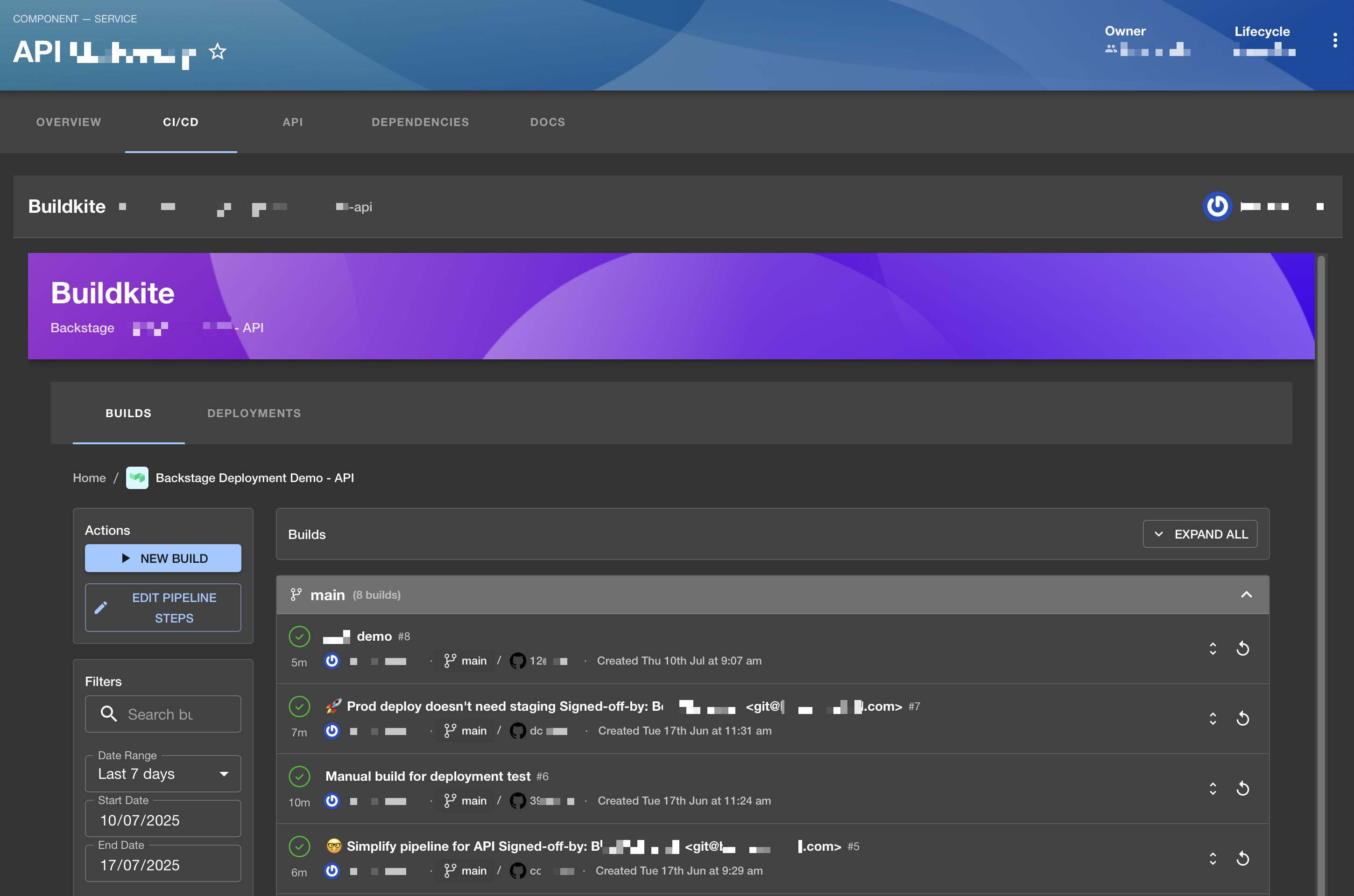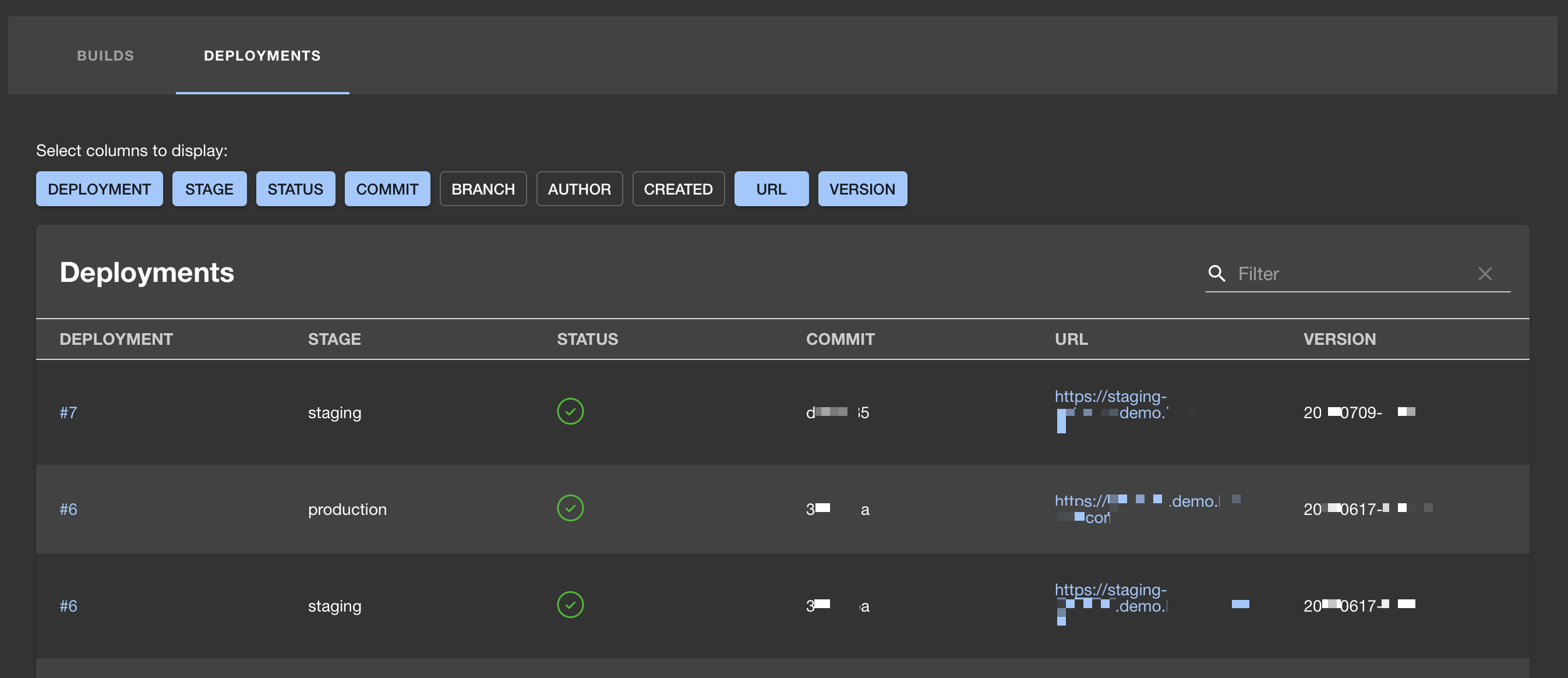Deployment visibility with Backstage
Backstage is an open source framework for building developer portals that provide unified visibility into your infrastructure's tools, services, and documentation. By integrating your Buildkite pipelines with Backstage using the Buildkite plugin for Backstage, you can monitor the status of your pipelines and manage their builds from a single interface.

Overview
The Buildkite plugin for Backstage transforms how your team manages deployments by providing:
- Centralized pipeline monitoring: view Buildkite pipeline status alongside your Backstage Service Catalog, eliminating the need to switch between multiple tools.
- Real-time build tracking: monitor build progress with automatic status updates.
- Build management: trigger rebuilds directly from Backstage.
- Detailed build information: access build logs, timing metrics, and commit context.
Setting up deployment visibility
To use Backstage for deployment visibility with Buildkite, you'll need to have:
- Admin access to both your Buildkite organization and Backstage instance.
- The Buildkite plugin for Backstage installed and configured.
- A valid Buildkite API access token with the following permissions:
read_pipelinesread_buildsread_user-
write_builds(for rebuild functionality)
- Existing deployment pipelines in Buildkite that you want to monitor.
- Deployment components annotated in your Backstage Software Catalog.
- Your deployment pipelines configured for optimal visibility.
Annotating deployment components
Connect your Backstage components to their corresponding Buildkite deployment pipelines by adding annotations to your catalog-info.yaml files:
apiVersion: backstage.io/v1alpha1
kind: Component
metadata:
name: my-production-service
annotations:
buildkite.com/pipeline-slug: my-org/production-deployment-pipeline
tags:
- production
- deployment
spec:
type: service
owner: platform-team
lifecycle: production
Note that the pipeline-slug must exactly match your Buildkite organization's slug and the pipeline slug.
It is also recommended to use descriptive tags to categorize and filter deployment components (for example, productionor deployment).
Organizing deployment pipelines
To maximize deployment visibility of your Buildkite pipelines in Backstage:
- Use consistent naming conventions for deployment pipelines (for example,
service-name-env-deploy). - Tag deployment builds with environment information using build metadata.
- Set up deployment-specific badges to visually identify deployment status.
Monitoring your deployments
When properly configured, the Backstage integration provides environment overview, deployment metrics, and build artifact tracking.

Best practices for deployment visibility
The following are some tips for optimizing your workflow in Buildkite Pipelines and Backstage for the best integration results.
Structure your pipelines
When naming your pipelines, use descriptive and consistent naming conventions that can scale:
my-service-ci # Continuous integration
my-service-deploy-dev # Development deployment
my-service-deploy-prod # Production deployment
Use deployment-specific metadata
Add metadata context to the configuration file of your deployment pipelines:
steps:
- label: "🚀 Deploy to Production"
command: deploy.sh
metadata:
environment: "production"
version: "$BUILDKITE_TAG"
deployed_by: "$BUILDKITE_BUILD_CREATOR"
Implement deployment gates
Use block steps to create approval gates visible in Backstage:
steps:
- block: "✋ Deployment Approval"
prompt: "Deploy to production?"
fields:
- text: "Release notes"
key: "release-notes"
required: true
Track deployment events
Configure your pipelines to emit deployment events that Backstage can consume:
# In your deployment script
buildkite-agent annotate "Deployed version ${VERSION} to ${ENVIRONMENT}" \
--style "success" \
--context "deployment-${ENVIRONMENT}"
Monitoring and alerting
Use Backstage's deployment visibility to:
- Configure notifications for failed deployments to set up deployment alerts.
- Generate regular deployment performance reports.
- Monitor service level objectives for deployments.
Troubleshooting deployment visibility
This section covers some common issues and the proposed mitigations for integration between Buildkite Pipelines and Backstage using the Buildkite plugin for Backstage.
API access token issues
If you are experiencing authentication errors, verify that:
-
Your Buildkite API access token:
- Has all required permissions.
- Is correctly set in your environment variables.
The proxy configuration in
app-config.yamlis correct.
Missing Buildkite deployments
If your Buildkite deployments aren't appearing in Backstage:
- Check that the annotation format is correct:
organization-slug/pipeline-slug. - Verify that the pipeline slug matches exactly what's shown in your Buildkite URL.
- Verify that your pipeline annotation exactly matches the deployment pipeline you're expecting to see.
- Ensure the component has been properly registered in your Backstage Software Catalog.
- Ensure the builds exist within the selected time range.
- Confirm that all filters are set correctly.
- Check that that your Buildkite API access token has sufficient permissions (
read_pipelines,read_builds,read_user, andwrite_builds, for rebuild functionality). - Confirm your deployment builds are properly tagged with deployment metadata.
Incomplete deployment information
To improve deployment data quality and make the deployment information complete:
- Add comprehensive build metadata and deployment metadata.
- Use consistent environment naming (for example,
production,staging,dev) and avoid variations like, for example,prod-eastandproduction-us-east-1for the same environment type. - Include version information in all deployment builds.
Missing real-time updates
If your Buildkite deployments show up in Backstage correctly, but you are experiencing issues with the synchronization of updates, do the following:
- Verify that your web browser tab is active as the updates pause in background tabs.
- Check your network connectivity.
- Ensure that the Buildkite API access token you are using hasn't expired.
Build logs are not loading
If you are experiencing an issue with loading logs from Buildkite deployments in Backstage:
- Check that the build exists and is accessible.
- Ensure the Buildkite API access token has
read_buildspermission. - Verify that your proxy configuration can handle log requests.